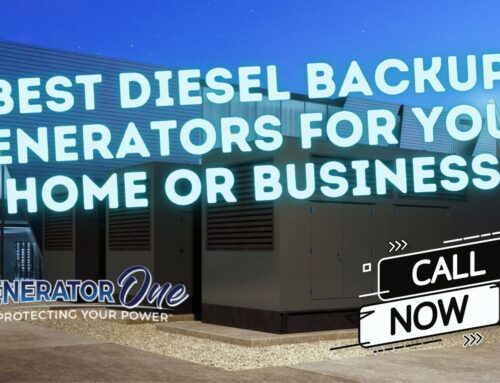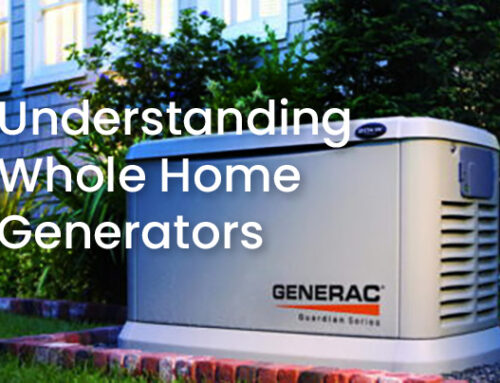In order to make your home the best that it can be, it’s important to have a power supply that’s both reliable and uninterrupted. But the truth of the matter is that power outages are unpredictable – whether blackouts are caused by inclement weather or downed lines – and they’re occurrences that tend to happen more often than we’d like.
With the onset of the COVID-19 pandemic, more people than ever before are working from home and depending on heating, cooling, lights, and wifi not only to stay comfortable, but to get work done and keep food on the table. Because there are so many people depending on electricity, the power grid is under much more strain than it’s used to. Before the majority of the workforce was at home, in 2019, power outages were simply inconvenient – sometimes expensive – but generally manageable.
In 2020, we look at power outages a bit differently. A power outage leaves you feeling helpless, stuck, and wondering who to call and when things will be back up and running. It’s not a great feeling, and no one should have to experience it.
That’s where the team at Generator One comes in. Backup generators such as Generac generators, restore a home’s emergency power within seconds of a power outage with an electric start, leaving no time for vulnerability or confusion. Once the transfer switch flips, it keeps everything running – the fridge, wifi, lights, water heater, sensitive electronics, covering all your power needs until the power comes back on.
A home standby generator isn’t a portable generator or an inverter generator. It works automatically so that there are no breaks in electricity and life can continue as normal.
If a power outage lasts for an indeterminate amount of time, longer than a few days, you might not even be able to stay in your home. Having a backup generator prevents you from having to leave the house when you least want to.
Installing a backup generator isn’t something you can do on your own. Instead, call the professionals at Generator One. Installation is much more involved than simply plugging in the generator and calling it good, but with Generator On, installation includes:
- Generator selection
- Project planning
- Local permitting
- Site preparation
- Pre-setting
- Utility coordination
- Warranty activation
- Maintenance and service
Because it’s so complex, we’ve created this generator buying guide to break things down and make the process easier to understand. It’s important to note that installation is the same for every brand of residential backup standby generators, and we at Generator One are skilled in all of them – and we’ll help you choose the right one for your home and lifestyle.
Generator Selection
The first step towards installation is choosing the right types of generator(s), and this is a delicate process – it’s the most important decision, which is why Generator One will be there with you every step of the way.
Talking to one of our highly trained specialists is necessary because we understand the amount of electrical service that a single family home needs. When it comes to electricity in your home, the last thing you want is too much or too little wattage.
Your generator’s performance will be affected by peak load demands (the highest amount of energy that you use at a time within your home) and multiple appliances running at the same time. In order to obtain a backup generator that works for you, a specialist at Generator One will determine what generator meets your home’s specific power requirements and can assist in making the perfect selection.
Power Capacity
Picking the right size generator for your home is important, and when making the decision, you must take into account a handful of factors. The team at Generator One will help you in making this decision, and determining the power capacity wattage that’s necessary for your home, which includes a calculation of the starting loads of every appliance in your home.
In order for your backup generator to work the way it’s supposed to, it has to meet your home’s power requirements. If it doesn’t, it will not perform how you want it to. If a generator is overloaded, it will place stress on the unit and even the appliances connected to it. In order to enjoy all the benefits of a backup generator in the event of a power outage, you have to have the correct size. If this is overwhelming, don’t worry. Generator One has it covered. You can depend on our specialists to correctly calculate the size of your generator’s wattage in volts.
Project Planning and Local Permitting
After selecting a generator, the next step in the process of installation calls for professional drawings, approvals, and permits which will all be managed and handled by Generator One. Sometimes, official site and surface surveys might be called for as well. Licensed contractors are necessary when it comes to installing a generator, and building permits can only be issued by local governments. As you can see, this is far from a one-person job. Keep in mind that, most of the time, it’s necessary for the homeowner to be home during inspections carried out by professionals.
Since generators always require an electrical and gas connection, permits and inspections are required for installation to check for gas connections – natural or liquid propane (LP). If an LP tank is needed, you can buy one and get it installed from a local dealer.
During inspections, the department looks for compliance with state and local building and electrical codes, guidelines, and rules. Generator One will attain permits from your local city/county building department. The building officials will go over these applications before issuing them, and potentially address further information like boundary surveys and flood height elevation certificates with Generator One. What they ask for depends on your location, as every jurisdiction has its differences.
When the building officials decide that the requirements are met, they issue the permit for each project. Once the project is over, it gets inspected by local authority who comes out to make sure that the standard of workmanship is satisfactory, and standards of safety have been upheld and are compliant with all codes.
Local Approvals and Permits
Approvals and permits are apt to change and vary depending on your geographical location. If needed Generator One will assist in gaining these. Here are a few examples of requirements to be met:
- Sometimes, HOAs/POAs approvals are needed before installation
- Certain permits may be needed depending on the gas line work that’s needed for generator connection
- Wetlands and flood zones need further consideration during installation
- Neighboring houses, lots, and buildings along with their electrical systems and gas utilities have to be considered
These requirements differ for every location. In order to find out what applies to you, a site survey will be done.
Location, Location, Location
Pre-Planning
Before your generator is delivered, it’s important for Generator One to properly plan. Generators typically weigh over 400 pounds, so it’s a good idea to make sure that there’s nothing in the way of where your generator is supposed to go, like boxes, extension cords, or other appliances. When it’s time to install it, your Generator One specialist definitely won’t want any obstructions.
Much like central air conditioners, standby backup power generators are installed permanently outside. It’s essential to know where the power sources like electrical and gas lines are easiest to access, because the generator will need to connect to them. Having this information on-hand before the delivery date usually works best. It’s also required to follow the manufacturer’s installation specifications for warranty protection and in order to stay compliant with building inspections.
Location
Generator One knows that finding an area that drains well and doesn’t flood is something to consider before your generator gets delivered. It’s also important to note that a generator can’t be any closer than 36 inches to any utility meters, AC units, combustibles or any serviceable appliance.
They also cannot be closer than 18 inches from the house, and they must be at least 60 inches away from doors, windows, and/or places where fresh air goes inside – this is to prevent leakage of carbon monoxide emissions into the home. Keeping 36 inches in front of the generator keeps it from being crowded, and allows your Generator One technician enough space for when they come for regular maintenance.
Plan for a space that’s at least 10’ x 10’. This is a space that’s large enough to fit the generator, and it also meets local codes and manufacturer requirements. In addition, the closer the generator is placed to the electric meter and natural gas line, the more money you’ll be able to save on installation.
Level Surface
The surface needs to be level for your generator to be installed, namely if Generator One is installing it on a pre-cast reinforced Gen-pad or a concrete pad. Along with a level surface, the landscaping in the area needs to be clear of plants and objects that could get in the way of technicians or their equipment. Before the delivery date, make sure to relocate decorative items so the space can be cleared. They can come back after the generator is installed.
In coastal areas or steep inclined grades, a specially designed platform is installed to make sure that the generator is above the floodplain.
Gas and Electric
Utility connections include gas choices, connections, and electrical installation. As we previously stated, all standby backup generators require a fuel source so that they can create electricity. You can choose between two sources: natural gas or liquid propane.
Natural Gas
Public utility provides and meters natural gas. This type of connection requires gas piping to be installed from the gas source to the location of your generator. If we’re installing a new natural gas line, it will call for an inspection by your Municipal Gas Inspection Office. After the line has been installed and inspected, it will require a final connection once it’s given a connection to the generator. Any of these specifics will be addressed by the team at Generator One.
Liquid Propane
Natural gas isn’t available in every area. In those cases, it’s necessary to use liquid propane. It requires professional installment of storage tanks. These tanks can be refilled by any provider, as needed.
The propane tanks come with a few options. You can bury them, leave them above ground, lease one or own one, have a singular large tank or multiple tanks that are smaller in size. Whichever you choose, LP always requires a storage tank that remains on your property. Generator One will check with your local ordinance to find out what restrictions might be in place on what type of tank you can use – LP companies provide plenty of choices, so you’re bound to find an option that fits your ordinance.
Differing Propane Prices
Propane dealers are private companies, unlike utility companies. The price depends on the competition in your specific area, along with market factors like weather and supply/demand. Shopping for propane is a lot like shopping for food or other essentials. Prices will vary at different stores, which means that it might be a good idea to shop around before you commit to a brand.
It’s important to note that the minimum size propane tank you’ll need to operate a backup generator is 250 gallons, but the recommended size is 500 gallons (because this size tank has a runtime that can last through a power outage extending several days).
LP Installation and Connection
After you pick the brand of LP that best fits your location, the company will visit the site to determine the scope of work planned. With them, you can talk about getting the required permits and scheduling the work required for the LP tank. Generator One will begin the permitting process and take care of installing and connecting the fuel to the generator. LP tank installation can take up to a week (maybe longer) depending on the company’s schedule, so it’s a good idea to get going on this as soon as you can.
Existing Gas Service
If you already have a gas service, that’s good news. But Generator One may require some necessary modifications for the new connection of your generator when it comes to underground service lines, LP tanks, or LP regulators. If one of these needs to be updated, you’ll need to contact your gas provider and request this done, which might call for an extra charge.
There’s no set amount of time that a gas installation takes. It all depends on your local municipality and permitting processes.
Service and Maintenance
Activation
After the electrical and gas connections, it’s finally time to get your generator started. All the components will be tested and verified that they’re working properly. After all of this is done, Generator One will demonstrate how the generator works and provide you with an owner’s manual.
After the testing and certification is finished, Generator One will order a final inspection from the municipality, which will most likely require direct contact from the homeowner when that inspection happens.
Depending on how the inspection goes, the inspector may require further work to be done on the generator and/or jobsite, which can sometimes happen. If this occurs, Generator One will schedule any changes that need to be made and easily complete the process.
Conclusion
As you can see from this buyer’s guide, installing a standby backup generator is no easy task. In fact, it’s one of the most difficult tasks of being a homeowner. The process itself is complex, but the use of your generator will be as simple as the flip of a transfer switch. While installation may be difficult, it’s definitely worth it. We created this guide in order to ease your mind and let you rest easy while Generator One does nearly all of the work when it comes to installing your generator.
An added component to consider from our reliable company is remote monitoring such as Generac MobileLink, as an example. Remote monitoring connects your generator to a cellular network and allows you to stay updated on your machinery via an app. Remote monitoring also helps technicians spot problems faster and get to the root of said problems more easily.
Generator One’s team has made over 5,000 Generac generator installations in the last 24 years, and we would love to add your home to our list. We offer free, no obligation, on-site or virtual visits, so give us a call today to see what we can do for you.




